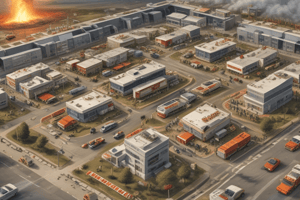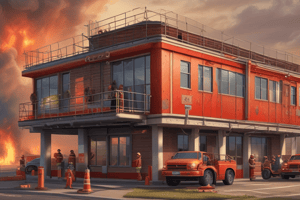Podcast
Questions and Answers
What is the primary responsibility of the first arriving division officer at an emergency incident?
What is the primary responsibility of the first arriving division officer at an emergency incident?
- To handle all firefighting operations personally
- To take command at the nearest fire station
- To initiate the basic incident command function (correct)
- To directly engage with the media
When is a Fixed Command structure preferred?
When is a Fixed Command structure preferred?
- When the incident commander is required to move frequently
- When quick action is prioritized over command control
- When multiple incidents are occurring simultaneously
- When environmental conditions are stable (correct)
In which scenario is Mobile Command utilized?
In which scenario is Mobile Command utilized?
- When the incident commander needs to remain stationary
- When investigating the situation alongside the crew (correct)
- When coordination with other units is required
- When the fire is deemed too dangerous for crew entry
What is one of the key responsibilities of establishing a command post?
What is one of the key responsibilities of establishing a command post?
Which of the following best describes Fixed Command?
Which of the following best describes Fixed Command?
What is the primary difference between passing command and transferring command?
What is the primary difference between passing command and transferring command?
What must the next arriving officer do upon accepting command?
What must the next arriving officer do upon accepting command?
How many times can command be passed during an incident?
How many times can command be passed during an incident?
What is the role of the fire alarm operator after command is passed?
What is the role of the fire alarm operator after command is passed?
What responsibility does the initial commander retain until command is formally accepted?
What responsibility does the initial commander retain until command is formally accepted?
What should happen after the transfer of command at a fire incident?
What should happen after the transfer of command at a fire incident?
Who has the responsibility to command all working incidents within the city limits?
Who has the responsibility to command all working incidents within the city limits?
If a Columbus Officer is maintaining a mobile command, what action should they take regarding command transfer?
If a Columbus Officer is maintaining a mobile command, what action should they take regarding command transfer?
What happens if a Columbus Fire Officer decides not to transfer command to a Suburban Battalion Officer?
What happens if a Columbus Fire Officer decides not to transfer command to a Suburban Battalion Officer?
What should a Columbus officer do if they decide to take command during an incident?
What should a Columbus officer do if they decide to take command during an incident?
What should a higher-ranking officer do when taking command of an incident?
What should a higher-ranking officer do when taking command of an incident?
What action should the Captain take if they anticipate the Battalion Chief will arrive later?
What action should the Captain take if they anticipate the Battalion Chief will arrive later?
What does the transfer of command brief include?
What does the transfer of command brief include?
What should be included in the Status Report transmitted after a transfer of command?
What should be included in the Status Report transmitted after a transfer of command?
If the Battalion Chief is expected soon, what should the Captain do regarding command?
If the Battalion Chief is expected soon, what should the Captain do regarding command?
What is one situation where mobile command is appropriate?
What is one situation where mobile command is appropriate?
What is a potential outcome of mobile command?
What is a potential outcome of mobile command?
What should a company officer do if a situation is not quickly stabilized?
What should a company officer do if a situation is not quickly stabilized?
When should passing command be considered?
When should passing command be considered?
Which example illustrates the concept of mobile command?
Which example illustrates the concept of mobile command?
Which condition does NOT justify mobile command?
Which condition does NOT justify mobile command?
What is the initial action of the officer with mobile command?
What is the initial action of the officer with mobile command?
What should follow the conclusion of mobile command?
What should follow the conclusion of mobile command?
What is the designation of the side of a building that faces the address unless otherwise stated?
What is the designation of the side of a building that faces the address unless otherwise stated?
Which side of the incident is designated as Bravo?
Which side of the incident is designated as Bravo?
What designation is used for the exposure to the right of the Alpha side of the incident?
What designation is used for the exposure to the right of the Alpha side of the incident?
If an incident occurs on the western side of a building, what designation is assigned to that side?
If an incident occurs on the western side of a building, what designation is assigned to that side?
Which of the following is a correct mapping of side designations to exposures?
Which of the following is a correct mapping of side designations to exposures?
What is the designation for the first floor in a multi-story structure?
What is the designation for the first floor in a multi-story structure?
Which division would correspond to the highest floor in a multi-story building?
Which division would correspond to the highest floor in a multi-story building?
Where is Division Bravo located in the building structure?
Where is Division Bravo located in the building structure?
What does Division Alpha indicate in the context of a multi-story structure?
What does Division Alpha indicate in the context of a multi-story structure?
Which division is directly above Division 2 in a multi-story structure?
Which division is directly above Division 2 in a multi-story structure?
What is the main purpose of monitoring the number of resources reporting to one supervisor?
What is the main purpose of monitoring the number of resources reporting to one supervisor?
Which organizational level is responsible for operations in a specified geographical area?
Which organizational level is responsible for operations in a specified geographical area?
When would you typically use a Branch in incident management?
When would you typically use a Branch in incident management?
How do Divisions and Groups operate in relation to each other?
How do Divisions and Groups operate in relation to each other?
Which of the following is an example of a Group?
Which of the following is an example of a Group?
What happens to the responsibility of a Division once a specific assignment is given to a Group?
What happens to the responsibility of a Division once a specific assignment is given to a Group?
Which of the following is NOT one of the significant management principles affected by Divisions and Groups?
Which of the following is NOT one of the significant management principles affected by Divisions and Groups?
In the context of functional assignments, which Group is specifically responsible for managing evacuation?
In the context of functional assignments, which Group is specifically responsible for managing evacuation?
What is one of the responsibilities of Division and Group Supervisors?
What is one of the responsibilities of Division and Group Supervisors?
Which Division is mentioned as part of the roster of Divisions?
Which Division is mentioned as part of the roster of Divisions?
What information is required for division or group supervisors regarding communication with the Command Post?
What information is required for division or group supervisors regarding communication with the Command Post?
Which of the following is NOT part of the 3T's information required for division/group supervisors?
Which of the following is NOT part of the 3T's information required for division/group supervisors?
When is it unnecessary to implement a division or group within a firefighting team?
When is it unnecessary to implement a division or group within a firefighting team?
What is the purpose of keeping the next higher level of command informed during an incident?
What is the purpose of keeping the next higher level of command informed during an incident?
Which of the following is NOT an example of a task for division or group supervisors?
Which of the following is NOT an example of a task for division or group supervisors?
Flashcards are hidden until you start studying
Study Notes
Fire Command Structure
- First arriving officer initiates command, establishes a command post, and assumes command responsibilities.
- Command Structure:
- Fixed Command: Incident commander maintains a fixed location, usually outside the structure, and focuses on command efforts.
- Mobile Command: Division officer or member accompanies their crew to investigate the situation.
- Pass Command: Initial officer or member passes command to the next arriving officer or member.
- Mobile Command Situations:
- Nothing showing and the division officer or member accompanies his/her crew to investigate the situation.
- Situations that are likely to be quickly contained with few resources committed.
- While awaiting the arrival of the next arriving officer after passing command.
- Passing Command:
- Considered when immediate action from the first arriving officer is needed to stabilize the situation.
- Should be considered when the first arriving officer's actions will improve the outcome of the incident.
- Command can be transferred to the next arriving officer or member when both Engine and Ladder companies arrive at the same time.
- The first arriving officer or member remains responsible for all duties of incident command until the next arriving officer or member formally accepts command.
- The next arriving officer or member obtains a CAN report from the initial arriving company, establishes a fixed command post, and provides a progress report.
Transfer of Command Procedure
- The outgoing officer briefs the incoming officer during a transfer of command.
- The transfer of command brief should include:
- Incident priorities and strategic goals.
- Tactical objectives assigned and to be assigned.
- Tactical objectives already achieved.
Responding with Suburban Fire Departments
- Suburban departments responding into the city of Columbus, Columbus fire officers below the rank of battalion chief have the option to take or maintain command of all incidents.
- A Columbus Fire Battalion Chief shall take command of all working incidents within the city limits.
Dividing the Incident
- Sides and Exposures:
- Each side of the fire building or incident area shall be designated as either Alpha, Bravo, Charlie, or Delta.
- The address side of the building will be referred to as Alpha side, with the designation moving clockwise around the structure.
- Building exposures should be identified with a similar system.
Divisions and Groups
- Divisions: Are used to divide an incident geographically.
- Groups: Are used to describe functional operation.
- Branches: Are used when the number of Divisions or Groups exceeds the span of control and can be either geographical or functional.
- Divisions and Groups are commanded by Supervisors.
Operational Procedures for Firefighting Teams
- When an Incident Commander establishes divisions and/or groups, the division or group supervisors will need the following information:
- Radio Designation.
- 3T's:
- Team.
- Task(s).
- Talkgroup(s).
- Each functional or geographical assignment does not need to be commanded by a Division or Group Supervisor.
- The next higher level of command should be kept informed of the status of resources within their area of responsibility.
Span of Control
- It is necessary for the incident commander to monitor the number of resources that report to one supervisor in order to maintain a safe and effective span-of-control.
Studying That Suits You
Use AI to generate personalized quizzes and flashcards to suit your learning preferences.




